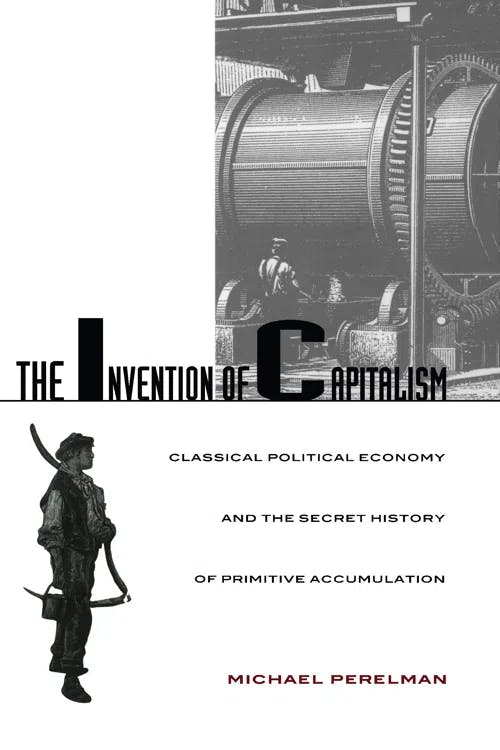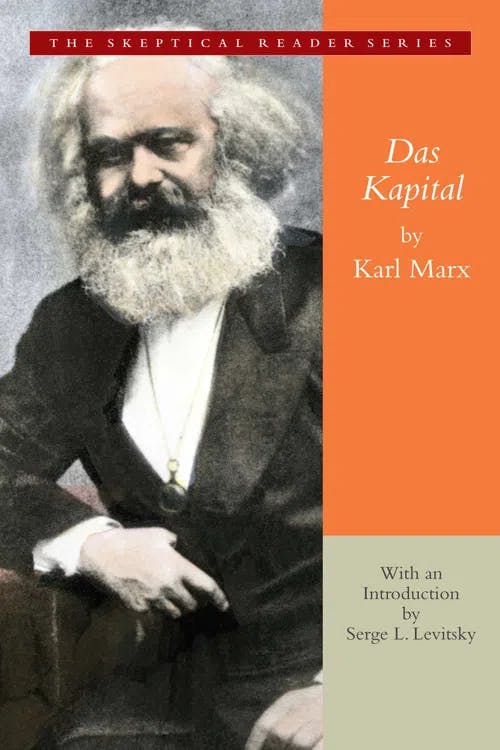What is Primitive Accumulation?
MA, Sociology (Freie Universität Berlin)
Date Published: 18.04.2023,
Last Updated: 25.07.2023
Share this article
Defining primitive accumulation
Primitive accumulation can be understood as capitalism’s origin story. It starts by asking the question, why is it that a small few own the means of production while the majority only have their labor to sell? As a dialectical materialist, Karl Marx sought an explanation that properly situated capitalism’s emergence within the annals of history.
Classical economists such as Adam Smith had argued that the free market emerged neatly and spontaneously, but Marx rejected this sanitized explanation. As Michael Perelman argues in The Invention of Capitalism (2000),
Marx […] believed that “capital comes dripping from head to toe, from every pore, with blood and dirt.” Workers were ‘‘tortured by grotesquely terroristic laws into accepting the discipline necessary for the system of wage-labour’’ [...]. Where Smith scrupulously avoided any analysis of social relations, Marx produced an elaborate study of the connection between the development of capitalistic social relations and so-called primitive accumulation.
Michael Perelman
Marx […] believed that “capital comes dripping from head to toe, from every pore, with blood and dirt.” Workers were ‘‘tortured by grotesquely terroristic laws into accepting the discipline necessary for the system of wage-labour’’ [...]. Where Smith scrupulously avoided any analysis of social relations, Marx produced an elaborate study of the connection between the development of capitalistic social relations and so-called primitive accumulation.
To understand just what is meant by this striking assertion, we will have to take a historical excursus back to the late 16th and 17th centuries — where western European societies transitioned from the feudal era of yore into the market societies that continue to shape our world today.
The story of primitive accumulation for Marx was one of violent plunder right from its outset. For him, this began with the exploits of explorers and an emergent mercantilist class whose conquests in the so-called New World flooded European shores with unprecedented amounts of gold and silver. This had significant impacts on the economy and the state, as merchant capital was increasingly important in undermining the feudal order and the influence of the aristocracy (whose power was tied to the land).
In order to adapt to the challenges of maintaining dominion over this mercantilist class, the state sought new principles of governance linked to the regulation of wealth with the aim of bringing it back into domestic circulation. It codified an assemblage of laws, decrees, and monetary regulations — including the establishment of the national banking system and the state’s capacity to issue national debt, which aided in the reinvestment and transition of wealth. These developments helped spur the Price Revolution and formed the infrastructure for investment capital, the private sector, and the market system. As Marx explains in Das Kapital (1867 [2012]),
But furthermore, and quite apart from the class of idle rentiers thus created, the improvised wealth of the financiers who play the role of middlemen between the government and the nation, and the tax-farmers, merchants and private manufacturers, for whom a good part of every national loan performs the service of a capital fallen from heaven, apart from all these people, the national debt has given rise to joint-stock companies, to dealings in negotiable effects of all kinds, and to speculation: in a word, it has given rise to stock-exchange gambling and the modern bankocracy.
Karl Marx
But furthermore, and quite apart from the class of idle rentiers thus created, the improvised wealth of the financiers who play the role of middlemen between the government and the nation, and the tax-farmers, merchants and private manufacturers, for whom a good part of every national loan performs the service of a capital fallen from heaven, apart from all these people, the national debt has given rise to joint-stock companies, to dealings in negotiable effects of all kinds, and to speculation: in a word, it has given rise to stock-exchange gambling and the modern bankocracy.
Yet, two key pieces of the puzzle still remain: how were feudal lands converted in the service of providing the raw materials necessary for commodity production? And where did the labor power to assemble them come from?
Taking England as an example, land and labor were made available through the passage of the Inclosure Acts, another key state intervention which facilitated the conditions necessary for early capital accumulation. In turn, as Marx argues, the enforcement of such enclosures resulted in the violent expropriation of peasants from their lands and means of subsistence:
The expropriation and eviction of a part of the agricultural population not only set free for industrial capital the workers, their means of subsistence and the materials of their labour; it also created the home market. In fact, the events that transformed the small peasants into wage labourers, and their means of subsistence and of labour into material [sachliche] elements of capital, created, at the same time, a home market for capital. (1867 [2012])
It is worth delving deeper into the ways in which privatization and marketization fundamentally altered the social fabric in the service of capital. As we’ll see next, the impacts of these laws dovetailed in all sorts of notable and surprising ways.
Primitive accumulation case study: women, witches and the closing of the commons
Today, it can be easy to take the conditions of wage labor for granted. Yet, it is a relatively recent social construct that was preceded by subsistence farming, which once constituted the entire way of life for the majority of people living in Europe prior to the processes of primitive accumulation. In order to explore the mixed social repercussions of this transition, it is helpful to look at the relationship between the closing of the commons and the persecution of women in the English witch trials. As Silvia Federici observes in Witches, Witch-Hunting and Women (2018),
Witch trials did not begin in England until the sixteenth century, peaking in the seventeenth, and [...] they occurred in societies where economic and social relations were being reshaped by the growing importance of the market, and where impoverishment and rising inequalities were rampant.
Silvia Federici
Witch trials did not begin in England until the sixteenth century, peaking in the seventeenth, and [...] they occurred in societies where economic and social relations were being reshaped by the growing importance of the market, and where impoverishment and rising inequalities were rampant.
Therefore, she concludes that,
There seems to be [...] a peculiar relationship between the dismantling of communitarian regimes and the demonization of members of the affected communities that makes witch-hunting an effective instrument of economic and social privatization. (2018)
In particular, Federici goes on to assert that, “the commercialization of land and the rise of monetary relations affected women and men differently” (2018). The targeting of women through witch hunts during the period of primitive accumulation demonstrates how the introduction of market relations resulted in new forms of stratification and discipline.
For one, as Federici observes in her research, women were especially affected by the enclosures. The commons had been a vital source of sustenance for widows, elderly, and poor women in particular. She argues that many of those who simply carried on taking what they needed from the now private lands were targeted by witch hunts:
Older women were most affected by these developments, for the combination of rising prices and the loss of customary rights left them with nothing to live on, especially if they were widows or had no children capable of or willing to help them. In the rural economy of the English manorial society, widows and poor people in general had been provided for. (2018)
Federici goes on to explain how the enclosures laid bare the inequalities that existed between these more precarious groups and those who were relatively better off. As a result, the privatization of lands also served to destroy the social cohesion that had existed prior to the closing of the commons:
Not surprisingly, many so-called witches were poor women [...]. Even the crimes imputed to them demonstrate that they were part of a peasant population that no longer had access to land or customary rights and could be expected to resent their neighbors’ possessions, beginning with their animals, which may have been grazing on land that had once been common. (2018)
Thus, the witch hunts served as a tool for disciplining errant women who did not comply with the processes of privatization and marketization. The terror of being accused as a witch was also instrumental in keeping other women in line. Federici argues that women had hitherto enjoyed a relative degree of freedom over their bodies and sexuality. They were also the keepers of vital knowledge about food and medicine that had enabled people to live off of the land. Yet, these qualities too became the target of the witch hunts. Federici writes,
[the “witch’s”] demeanor contradicted the model of femininity that through the law, the pulpit, and the reorganization of the family was imposed on the female population of Europe during this period. At times she was a healer and practitioner of various forms of magic that made her popular in the community, but this increasingly signaled her as a danger to the local and national power structure in its warfare against every form of popular power. (2018)
Thus, women in particular had more to lose in the process of primitive accumulation. As a result, they were heavily implicated in peasant resistance to the Inclosure Acts, participating in “many protests” and “pulling up the fences that now surrounded the commons” (Federici, 2018).
These forms of criminalization both helped to push women into the fold of capitalism and institutionalize patriarchy. Through the processes of primitive accumulation that created reliance on wage labor to meet their needs, women were paid only a fraction of their male counterparts’ wage and thus became much more dependent on — and subordinate to — their husbands.
This case study, then, offers an example of how capitalism can exploit and exacerbate inequalities — a central point of study for political economists to this day. Moreover, it illustrates the myriad and far-reaching repercussions of marketization, which Federici contends fundamentally alter our relations to ourselves, each other, and the world around us. As Federici writes,
together with the ‘witches,’ a world of social/cultural practices and beliefs that had been typical of precapitalist rural Europe, but which had come to be viewed as unproductive and potentially dangerous for the new economic order, was wiped out. It was a world that we now call superstitious but that at the same time alerts us to the existence of other possibilities in our relationship to the world. In this sense, we have to think of the enclosures as a broader phenomenon than simply the fencing off of land. We must think of an enclosure of knowledge, of our bodies, and of our relationship to other people and nature. (2018)
Silvia Federici
together with the ‘witches,’ a world of social/cultural practices and beliefs that had been typical of precapitalist rural Europe, but which had come to be viewed as unproductive and potentially dangerous for the new economic order, was wiped out. It was a world that we now call superstitious but that at the same time alerts us to the existence of other possibilities in our relationship to the world. In this sense, we have to think of the enclosures as a broader phenomenon than simply the fencing off of land. We must think of an enclosure of knowledge, of our bodies, and of our relationship to other people and nature. (2018)
Thus far, we’ve focused on primitive accumulation as the prehistory that enabled the conditions necessary for capitalism to take hold. Yet these processes have been ongoing ever since, and continue even in the present day.
Primitive accumulation today: accumulation by dispossession
Expropriation is the starting-point of the capitalist mode of production, whose goal it is to carry it through to completion, and even in the last instance to expropriate all individuals. (Marx, 1867 [2012])
Marx makes this assertion because, in his view, capitalism must continue to expand and find new markets or else it will fall into crisis. These conditions are absolutely necessary for the ongoing accumulation of capital.
Just as in the specific period of primitive accumulation, therefore, David Harvey suggests that much of these same processes of expropriation are continuously taking place around the world through what he calls “accumulation by dispossession”. As Alex Callinicos summarizes in “David Harvey and Marxism”, David Harvey: A Critical Reader (2008), Harvey reinterprets
primitive accumulation as ‘accumulation by dispossession’, not a long-surpassed originary stage of capitalist development but a continuing process expressed today in the relentless commodification of the world [...]
Edited by Noel Castree and Derek Gregory
primitive accumulation as ‘accumulation by dispossession’, not a long-surpassed originary stage of capitalist development but a continuing process expressed today in the relentless commodification of the world [...]
In his work, Harvey explores numerous examples of accumulation by dispossession — particularly as corporations in the Global North enter crises of overaccumulation and seek to expand to new markets in the Global South.
One relatively recent manifestation of this can be found in the Cochabamba Water War of 1999 and 2000. In conjunction with the Bechtel Corporation and with the support of the World Bank, the Bolivian government sought to privatize the water supply. As part of this maneuver, it also criminalized the collection of rainwater for consumption — meaning that indigenous people and the poor would not have access to water except through the market. The motion, however, was met with staunch resistance which quickly spread across the nation. As Nasya Sara Razavi outlines in Water Governance in Bolivia (2022),
the Water War [...] rejected privatization and demanded water services be returned to the public sphere. The concept of social control that emerged from the water movement at this time centred around this demand and the resolve to democratize the water system through greater citizen involvement in governance (Aguilar Miranda & Miranda Hernández, 2012). The Water War can also be understood as a catalyst for broader change in Bolivia, sparking further resource wars and a shift to the left with the election of Evo Morales and the MAS party in December 2005 [...]. Morales responded to water sector demands with the formal recognition of the Right to Water as well as the traditional model of uses and customs.
Nasya Sara Razavi
the Water War [...] rejected privatization and demanded water services be returned to the public sphere. The concept of social control that emerged from the water movement at this time centred around this demand and the resolve to democratize the water system through greater citizen involvement in governance (Aguilar Miranda & Miranda Hernández, 2012). The Water War can also be understood as a catalyst for broader change in Bolivia, sparking further resource wars and a shift to the left with the election of Evo Morales and the MAS party in December 2005 [...]. Morales responded to water sector demands with the formal recognition of the Right to Water as well as the traditional model of uses and customs.
As this example illustrates, the story of capitalism — beginning with primitive accumulation — has always been one of ongoing struggles. While the tendency toward boundless expansion in search of new markets continues to profoundly reshape the terrain of social life, these processes remain uneven and riddled with controversy.
Closing thoughts
Primitive accumulation offers an explanation for the origins of capitalism. Its starting point is Marx’s argument that
the accumulation of capital presupposes surplus-value; surplus-value presupposes capitalistic production; capitalistic production presupposes the pre-existence of considerable masses of capital and of labor-power in the hands of producers of commodities. The whole movement, therefore, seems to turn in a vicious circle, out of which we can only get by supposing a primitive accumulation (previous accumulation of Adam Smith) preceding capitalistic accumulation; an accumulation not the result of the capitalist mode of production, but its starting point. (1867 [2012])
Karl Marx
the accumulation of capital presupposes surplus-value; surplus-value presupposes capitalistic production; capitalistic production presupposes the pre-existence of considerable masses of capital and of labor-power in the hands of producers of commodities. The whole movement, therefore, seems to turn in a vicious circle, out of which we can only get by supposing a primitive accumulation (previous accumulation of Adam Smith) preceding capitalistic accumulation; an accumulation not the result of the capitalist mode of production, but its starting point. (1867 [2012])
In contrast to the more sanitized version put forth by liberal economists like Adam Smith, what Marx found was that this transition was a violent and bloody one ushered in by conscious policy measures. Federici’s historical account expands on this point by demonstrating how the imposition of market relations helped to institutionalize patriarchal subordination of women. From this, she concludes that the privatization of land produced conditions of stratification (where people had once lived communally). David Harvey then argues that these processes are not merely a thing of the past but ongoing, as capitalism continues to satisfy its need for constant growth through means of dispossession. Thus, the story of primitive accumulation can also offer us insights into the makings of contemporary society.
Further primitive accumulation resources & reading on Perlego
Rethinking Capitalist Development by Kalyan Sanyal
Gendered States of Punishment and Welfare by Adrienne Roberts
Classical Political Economy by Michael Perelman
The Global Governance of Precarity by Nick Bernards
Karl Marx's Grundrisse, edited by Marcello Musto
A Companion To Marx's Capital by David Harvey
Cannibal Capitalism by Nancy Fraser
What is primitive accumulation in simple terms?
What is an example of primitive accumulation?
Which scholars are associated with primitive accumulation?
Bibliography
Castree, N. & Gregory, D. (eds.) (2008) David Harvey: A Critical Reader. Wiley-Blackwell. Available at: https://www.perlego.com/book/2757106/david-harvey-a-critical-reader-pdf
Federici, S. (2018) Witches, Witch-Hunting, and Women. PM Press. Available at: https://www.perlego.com/book/2585050/witches-witchhunting-and-women-pdf
Marx, K. (2012) Das Kapital. Gateway Editions. Available at: https://www.perlego.com/book/784600/das-kapital-a-critique-of-political-economy-pdf
Musto, M. (ed.) (2008) Karl Marx’s Grundrisse. Routledge. Available at: https://www.perlego.com/book/717802/karl-marxs-grundrisse-pdf
Perelman, M. (2000) The Invention of Capitalism. Duke University Press Books. Available at: https://www.perlego.com/book/1467121/the-invention-of-capitalism-classical-political-economy-and-the-secret-history-of-primitive-accumulation-pdf
Razavi, N. S. (2022) Water Governance in Bolivia. Routledge. Available at: https://www.perlego.com/book/3288908/water-governance-in-bolivia-cochabamba-since-the-water-war-pdf
MA, Sociology (Freie Universität Berlin)
Lily Cichanowicz has a master's degree in Sociology from Freie Universität Berlin and a dual bachelor's degree from Cornell University in Sociology and International Development. Her research interests include political economy, labor, and social movements. Her master's thesis focused on the labor shortages in the food service industry following the Covid-19 pandemic.





